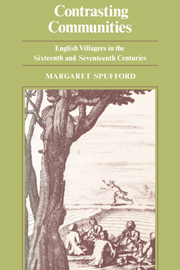Book contents
- Frontmatter
- Contents
- List of maps and graphs
- List of tables
- List of abbreviations
- Acknowledgements
- Dedication
- Introduction
- Map 1 Cambridgeshire: natural boundaries and soil types
- Map 2 Cambridgeshire: county and parish boundaries
- PART 1 People, Families and Land
- 1 The peopling of a county
- 2 The problem: the disappearance of the small landowner
- 3 The reality: the small landholder on the chalk: Chippenham
- 4 The reality: the small landholder on the clay: Orwell
- 5 The reality: the small landholder in the fens: Willingham
- General Conclusions to Part One
- PART 2 The Schooling of the Peasantry
- PART 3 Parishioners and their Religion
- Conclusion
- Appendix 1 The Butlers of Orwell
- Appendix 2 Notes on Graphs 3 and 5
- Index of Contemporary Names
- General Index
2 - The problem: the disappearance of the small landowner
Published online by Cambridge University Press: 25 January 2010
- Frontmatter
- Contents
- List of maps and graphs
- List of tables
- List of abbreviations
- Acknowledgements
- Dedication
- Introduction
- Map 1 Cambridgeshire: natural boundaries and soil types
- Map 2 Cambridgeshire: county and parish boundaries
- PART 1 People, Families and Land
- 1 The peopling of a county
- 2 The problem: the disappearance of the small landowner
- 3 The reality: the small landholder on the chalk: Chippenham
- 4 The reality: the small landholder on the clay: Orwell
- 5 The reality: the small landholder in the fens: Willingham
- General Conclusions to Part One
- PART 2 The Schooling of the Peasantry
- PART 3 Parishioners and their Religion
- Conclusion
- Appendix 1 The Butlers of Orwell
- Appendix 2 Notes on Graphs 3 and 5
- Index of Contemporary Names
- General Index
Summary
The importance of mounting population pressure, and therefore of the upward movement of food prices between 1500 and 1650, lies in the profound effect these changes had on the whole structure of rural society, and on the distribution of its land. It is necessary to glance back at the medieval distribution of land before appreciating the magnitude of the changes which took place in the sixteenth and seventeenth centuries.
Admittedly, the somewhat egalitarian picture of medieval manorial society that emerges from the great surveys of the thirteenth century, taken when pressure on land and seigneurial power was at its height, is probably partly the result of the need of estate-owners to maintain the integrity of holdings for administrative purposes. The neat tenements of half a yardland, which form the holdings of such a large proportion of the unfree tenants who were lucky enough to have land at all, on the open-field manors of eastern England may not have been in reality nearly such tidy units as they appeared in the hundred rolls. However, even if the true state of affairs was complicated by subletting amongst the unfree tenants, it probably remains true that only a small minority of villeins held as much as thirty acres of land at the end of the thirteenth century. In all, exactly six villein tenants in the four eastern counties surveyed in 1297 had over thirty acres.
- Type
- Chapter
- Information
- Contrasting CommunitiesEnglish Villages in the Sixteenth and Seventeenth Centuries, pp. 46 - 57Publisher: Cambridge University PressPrint publication year: 1974
- 4
- Cited by



